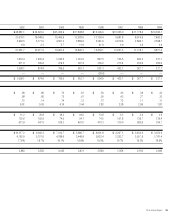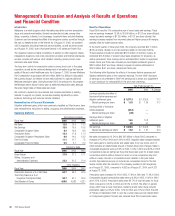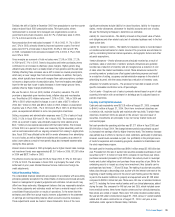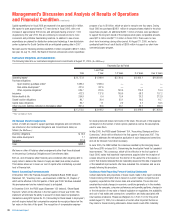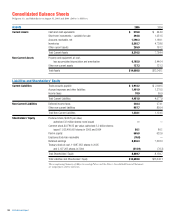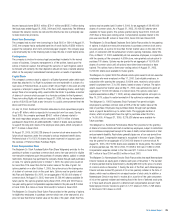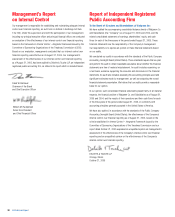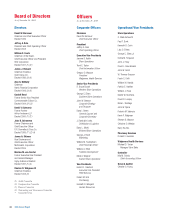Walgreens 2005 Annual Report Download - page 28
Download and view the complete annual report
Please find page 28 of the 2005 Walgreens annual report below. You can navigate through the pages in the report by either clicking on the pages listed below, or by using the keyword search tool below to find specific information within the annual report.
Summary of Major Accounting Policies
Description of Business
The company is principally in the retail drugstore business and its operations are
within one reportable segment. Stores are located in 45 states and Puerto Rico.
At August 31, 2005, there were 4,950 retail drugstores and three mail service
facilities. Prescription sales were 63.7% of total sales for fiscal 2005 compared
to 63.2% in 2004 and 62.0% in 2003.
Basis of Presentation
The consolidated statements include the accounts of the company and its
subsidiaries. All significant intercompany transactions have been eliminated.
Certain amounts in the 2004 and 2003 consolidated financial statements have
been reclassified to be consistent with the 2005 presentation. The consolidated
financial statements are prepared in accordance with accounting principles
generally accepted in the United States of America and include amounts based
on management’s prudent judgments and estimates. Actual results may differ
from these estimates.
Cash and Cash Equivalents
Cash and cash equivalents include cash on hand and all highly liquid investments
with an original maturity of three months or less. Included in cash and cash
equivalents are credit card and debit card receivables from banks, which settle
within two business days, of $55.4 million at August 31, 2005, and $53.3 million at
August 31, 2004. The company’s cash management policy provides for controlled
disbursement. As a result, the company maintains overdraft positions at certain
banks. Such overdrafts, which were $339.4 million as of August 31, 2005, and
$226.7 million as of August 31, 2004, are included in trade accounts payable in
the accompanying consolidated balance sheets.
Short-Term Investments – Available for Sale
The company’s short-term investments – available for sale are principally
auction rate securities. The company invests in municipal bonds and student
obligations and purchases these securities at par. The underlying security is
issued as a long-term investment. However, auction rate securities are classified
as short-term investments because they typically can be purchased and sold
every 7, 28 and 35 days. The trading of auction rate securities takes place
through a descending price auction with an interest rate reset at the beginning
of each holding period. At the end of each holding period the interest is paid
to the investor. The unrealized gains on these securities at August 31, 2005
and 2004, were not significant.
Financial Instruments
The company had $66.2 million and $77.2 million of outstanding letters of
credit at August 31, 2005 and 2004, respectively, which guaranteed foreign
trade purchases. Additional outstanding letters of credit of $313.8 million and
$156.2 million at August 31, 2005 and 2004, respectively, guaranteed payments
of casualty claims. The casualty claim letters of credit are annually renewable and
will remain in place until the casualty claims are paid in full. Letters of credit of
$1.7 million and $1.6 million were outstanding at August 31, 2005 and 2004,
respectively, to guarantee performance of construction contracts. The company
pays a nominal facility fee to the financing bank to keep these letters of credit
active. The company also had purchase commitments of approximately $437.6
million and $378.4 million at August 31, 2005 and 2004, respectively, related to
the purchase of store locations and distribution centers. There were no investments
in derivative financial instruments during fiscal 2005 and 2004.
Inventories
Inventories are valued on a lower of last-in, first-out (LIFO) cost or market
basis. At August 31, 2005 and 2004, inventories would have been greater by
$804.2 million and $736.4 million, respectively, if they had been valued on a
lower of first-in, first-out (FIFO) cost or market basis. Included in inventory is
product cost and inbound freight. Cost of sales is primarily derived based upon
point-of-sale scanning information with an estimate for shrinkage and is adjusted
based on periodic inventories. In addition to merchandise cost, cost of sales
includes warehousing costs, purchasing costs, freight costs and vendor
allowances not included as a reduction of advertising expense.
Vendor Allowances
Vendor allowances are principally received as a result of purchases, sales or
promotion of vendors’ products. Allowances are generally recorded as a reduction
of inventory and are recognized as a reduction of cost of sales when the related
merchandise is sold. Those allowances received for promoting vendors’ products
are offset against advertising expense and result in a reduction of selling, occupancy
and administration expenses to the extent of advertising costs incurred, with the
excess treated as a reduction of inventory costs. Prior to the adoption of EITF
Issue No. 02-16, “Accounting by a Customer (including a Reseller) for Certain
Consideration Received from a Vendor,” in January 2003, the entire advertising
allowance received was credited to advertising expense and resulted in a reduction
of selling, occupancy and administration expense.
Property and Equipment
Depreciation is provided on a straight-line basis over the estimated useful lives of
owned assets. Leasehold improvements and leased properties under capital leases
are amortized over the estimated physical life of the property or over the term of
the lease, whichever is shorter. Estimated useful lives range from 12 1
/2to 39 years
for land improvements, buildings and building improvements and 5 to 121
/2years
for equipment. Major repairs, which extend the useful life of an asset, are capitalized
in the property and equipment accounts. Routine maintenance and repairs
are charged against earnings. The composite method of depreciation is used
for equipment; therefore, gains and losses on retirement or other disposition
of such assets are included in earnings only when an operating location is
closed, completely remodeled or impaired. Fully depreciated property and
equipment are removed from the cost and related accumulated depreciation
and amortization accounts.
Property and equipment consists of (In Millions):
2005 2004
Land and land improvements
Owned stores $ 1,459.4 $1,215.6
Distribution centers 81.6 80.1
Other locations 59.1 40.8
Buildings and building improvements
Owned stores 1,521.3 1,322.4
Leased stores (leasehold improvements only) 500.5 478.4
Distribution centers 453.0 415.6
Other locations 183.5 162.8
Equipment
Stores 2,853.9 2,438.1
Distribution centers 679.8 623.9
Other locations 166.0 150.0
Capitalized system development costs 143.7 123.0
Capital lease properties 48.4 43.6
8,150.2 7,094.3
Less: accumulated depreciation and amortization 1,985.2 1,647.9
$ 6,165.0 $5,446.4
26 2005 Annual Report





